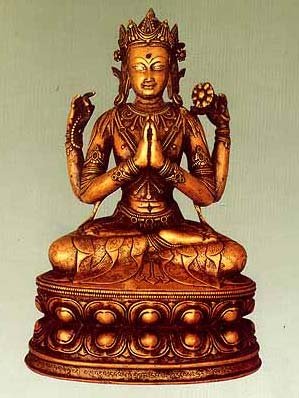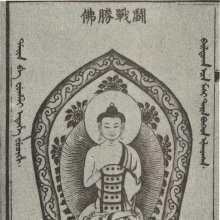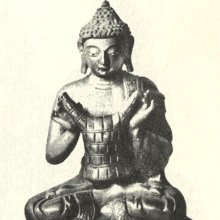Yuddhajaya, Yuddha-jaya: 1 definition
Introduction:
Yuddhajaya means something in Buddhism, Pali. If you want to know the exact meaning, history, etymology or English translation of this term then check out the descriptions on this page. Add your comment or reference to a book if you want to contribute to this summary article.
Images (photo gallery)
In Buddhism
Mahayana (major branch of Buddhism)
Source: academia.edu: A Study and Translation of the GaganagañjaparipṛcchāYuddhajaya (युद्धजय) is the name of a Bodhisatva, according to the Gaganagañjaparipṛcchā: the eighth chapter of the Mahāsaṃnipāta (a collection of Mahāyāna Buddhist Sūtras).—Accordingly, “Thus have I heard once. The Lord was staying in the place of the Tathāgata, the courtyard adorned with jewels, [...] With him there was also a great congregation of Bodhisattvas. [...] They were the Bodhisatva Yuddhajaya, [...] and so on, in company with immeasurable, innumerable, incalculable, inconceivable, unequalled, incomparable, infinite, ineffable Bodhisatvas, the great beings”.

Mahayana (महायान, mahāyāna) is a major branch of Buddhism focusing on the path of a Bodhisattva (spiritual aspirants/ enlightened beings). Extant literature is vast and primarely composed in the Sanskrit language. There are many sūtras of which some of the earliest are the various Prajñāpāramitā sūtras.
See also (Relevant definitions)
Partial matches: Yuddha, Jaya.
Starts with: Yuddhajayaprakasha, Yuddhajayarnava.
Full-text: Yuddhajayopaya, Yuddhajayaprakasha, Yuddhajayarnava.
Relevant text
Search found 2 books and stories containing Yuddhajaya, Yuddha-jaya; (plurals include: Yuddhajayas, jayas). You can also click to the full overview containing English textual excerpts. Below are direct links for the most relevant articles:
Related products

